Chirality Distributions for Semiconducting Single-Walled Carbon Nanotubes Determined by Photoluminescence Spectroscopy
Abstract
:1. Introduction
2. Experimental
2.1. Sample Preparation
2.2. Methods
2.2.1. PL Measurement System
2.2.2. Chirality Assignment
3. Results and Discussion
4. Conclusions
Author Contributions
Funding
Institutional Review Board Statement
Informed Consent Statement
Acknowledgments
Conflicts of Interest
Appendix A
| (11,0) | 0.87 | 0.00 | 0 | 0 |
| (14,0) | 1.11 | 0.00 | 2 | 1 |
| (14,1) | 1.15 | 3.42 | 1 | 0 |
| (12,1) | 0.99 | 3.96 | 13 | 0 |
| (13,2) | 1.12 | 7.05 | 2 | 0 |
| (10,2) | 0.88 | 8.95 | 0 | 0 |
| (13,3) | 1.17 | 10.16 | 5 | 3 |
| (11,3) | 1.01 | 11.74 | 14 | 1 |
| (12,4) | 1.14 | 13.90 | 5 | 2 |
| (11,4) | 1.07 | 14.92 | 0 | 1 |
| (12,5) | 1.20 | 16.63 | 19 | 5 |
| (9,4) | 0.92 | 17.48 | 0 | 0 |
| (10,5) | 1.05 | 19.11 | 25 | 7 |
| (11,6) | 1.19 | 20.36 | 9 | 4 |
| (10,6) | 1.11 | 21.79 | 3 | 3 |
| (11,7) | 1.25 | 22.69 | 1 | 0 |
| (8,6) | 0.97 | 25.28 | 0 | 0 |
| (9,7) | 1.10 | 25.87 | 84 | 28 |
| (10,8) | 1.24 | 26.33 | 1 | 1 |
| (8,7) | 1.03 | 27.80 | 5 | 3 |
| (9,8) | 1.17 | 28.05 | 59 | 25 |
| (10,9) | 1.31 | 28.26 | 0 | 0 |
| Parameter | 248 | 84 |
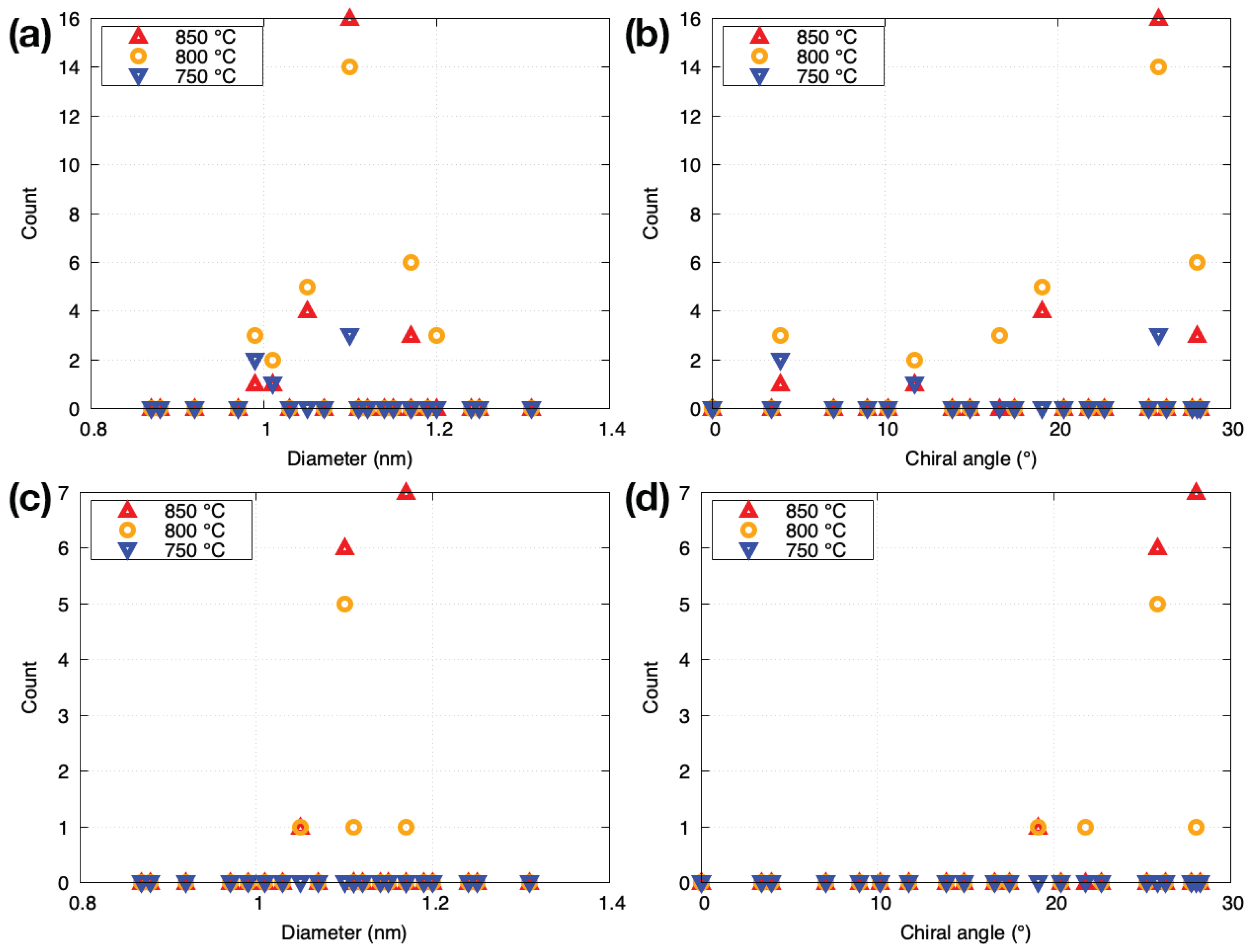
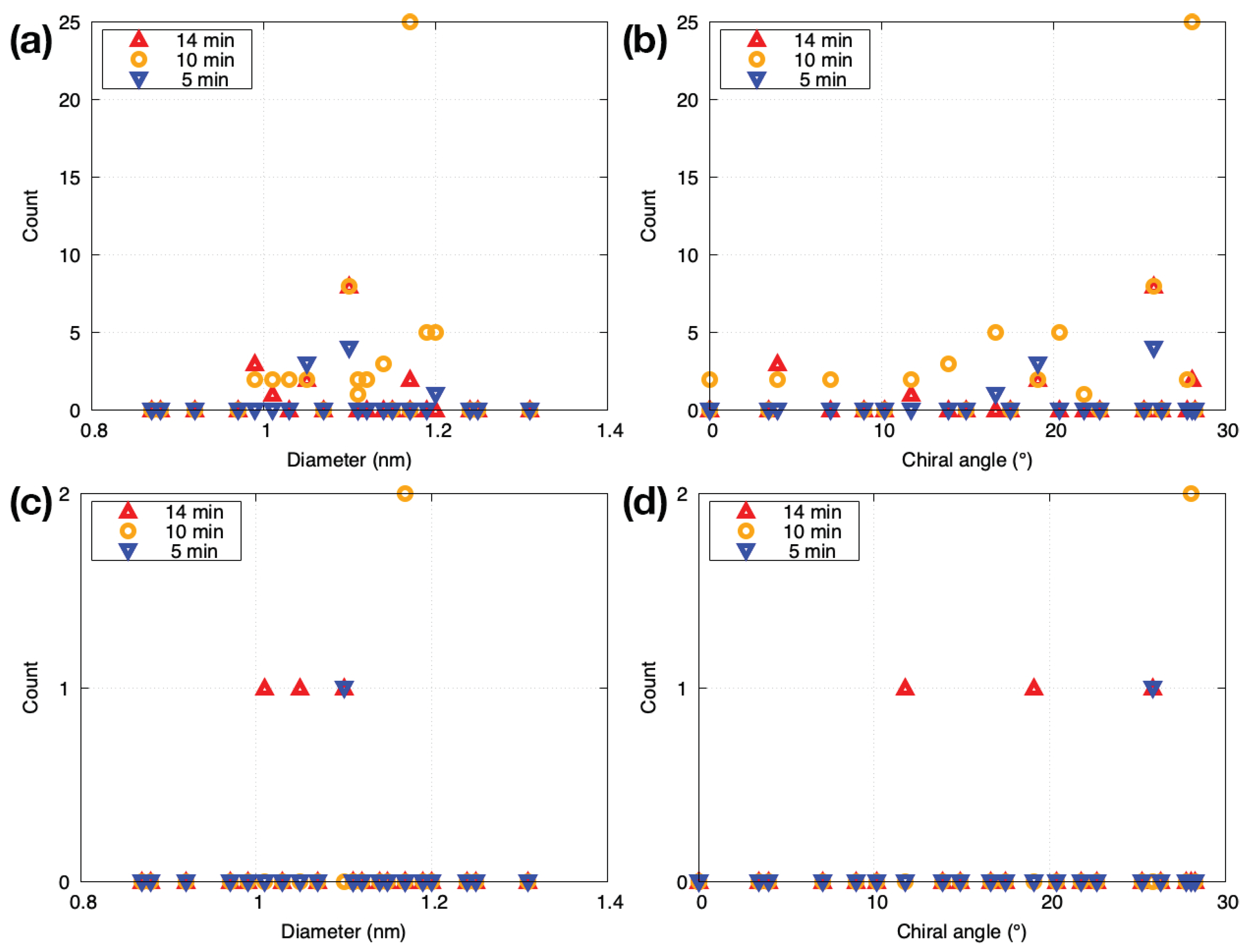
References
- Iijima, S.; Ichihashi, T. Single-shell carbon nanotubes of 1-nm diameter. Nature 1993, 363, 603–605. [Google Scholar] [CrossRef]
- Dresselhaus, M.S.; Dresselhaus, G.; Avouris, P. (Eds.) Carbon Nanotubes. In Topics in Applied Physics; Springer: Berlin/Heidelberg, Germany, 2001; Volume 80. [Google Scholar] [CrossRef]
- Yang, F.; Wang, X.; Zhang, D.; Yang, J.; Luo, D.; Xu, Z.; Wei, J.; Wang, J.Q.; Xu, Z.; Peng, F.; et al. Chirality-specific growth of single-walled carbon nanotubes on solid alloy catalysts. Nature 2014, 510, 522–524. [Google Scholar] [CrossRef] [PubMed]
- Yang, F.; Wang, M.; Zhang, D.; Yang, J.; Zheng, M.; Li, Y. Chirality pure carbon nanotubes: Growth, sorting, and characterization. Chem. Rev. 2020, 120, 2693–2758. [Google Scholar] [CrossRef]
- Sugime, H.; Sato, T.; Nakagawa, R.; Hayashi, T.; Inoue, Y.; Noda, S. Ultra-long carbon nanotube forest via in situ supplements of iron and aluminum vapor sources. Carbon 2021, 172, 772–780. [Google Scholar] [CrossRef]
- Burton, W.K.; Cabrera, N.; Frank, F.C. Role of dislocations in crystal growth. Nature 1949, 163, 398–399. [Google Scholar] [CrossRef]
- Ding, F.; Harutyunyan, A.R.; Yakobson, B.I. Dislocation theory of chirality-controlled nanotube growth. Proc. Natl. Acad. Sci. USA 2009, 106, 2506–2509. [Google Scholar] [CrossRef] [PubMed] [Green Version]
- Bachilo, S.M.; Strano, M.S.; Kittrell, C.; Hauge, R.H.; Smalley, R.E.; Weisman, R.B. Structure-assigned optical spectra of single-walled carbon nanotubes. Science 2002, 298, 2361–2366. [Google Scholar] [CrossRef] [PubMed] [Green Version]
- Bachilo, S.M.; Balzano, L.; Herrera, J.E.; Pompeo, F.; Resasco, D.E.; Weisman, R.B. Narrow (n,m)-distribution of single-walled carbon nanotubes grown using a solid supported catalyst. J. Am. Chem. Soc. 2003, 125, 11186–11187. [Google Scholar] [CrossRef]
- Miyauchi, Y.; Chiashi, S.; Murakami, Y.; Hayashida, Y.; Maruyama, S. Fluorescence spectroscopy of single-walled carbon nanotubes synthesized from alcohol. Chem. Phys. Lett. 2004, 387, 198–203. [Google Scholar] [CrossRef]
- Hirahara, K.; Kociak, M.; Bandow, S.; Nakahira, T.; Itoh, K.; Saito, Y.; Iijima, S. Chirality correlation in double-wall carbon nanotubes as studied by electron diffraction. Phys. Rev. B 2006, 73, 195420. [Google Scholar] [CrossRef] [Green Version]
- Artyukhov, V.I.; Penev, E.S.; Yakobson, B.I. Why nanotubes grow chiral. Nat. Commun. 2014, 5, 1–6. [Google Scholar] [CrossRef] [PubMed] [Green Version]
- Kataura, H.; Kumazawa, Y.; Maniwa, Y.; Umezu, I.; Suzuki, S.; Ohtsuka, Y.; Achiba, Y. Optical properties of single-wall carbon nanotubes. Synth. Met. 1999, 103, 2555–2558. [Google Scholar] [CrossRef]
- Jorio, A.; Saito, R.; Hafner, J.H.; Lieber, C.M.; Hunter, M.; McClure, T.; Dresselhaus, G.; Dresselhaus, M.S. Structural (n,m) determination of isolated single-wall carbon nanotubes by resonant Raman scattering. Phys. Rev. Lett. 2001, 86, 1118–1121. [Google Scholar] [CrossRef]
- Lefebvre, J.; Homma, Y.; Finnie, P. Bright Band Gap Photoluminescence from Unprocessed Single-Walled Carbon Nanotubes. Phys. Rev. Lett. 2003, 90, 217401. [Google Scholar] [CrossRef]
- Jiang, H.; Nasibulin, A.G.; Brown, D.P.; Kauppinen, E.I. Unambiguous atomic structural determination of single-walled carbon nanotubes by electron diffraction. Carbon 2007, 45, 662–667. [Google Scholar] [CrossRef]
- He, M.; Liu, B.; Chernov, A.I.; Obraztsova, E.D.; Kauppi, I.; Jiang, H.; Anoshkin, I.; Cavalca, F.; Hansen, T.W.; Wagner, J.B.; et al. Growth mechanism of single-walled carbon nanotubes on iron-copper catalyst and chirality studies by electron diffraction. Chem. Mater. 2012, 24, 1796–1801. [Google Scholar] [CrossRef]
- Chiashi, S.; Kono, K.; Matsumoto, D.; Shitaba, J.; Homma, N.; Beniya, A.; Yamamoto, T.; Homma, Y. Adsorption effects on radial breathing mode of single-walled carbon nanotubes. Phys. Rev. B Condens. Matter Mater. Phys. 2015, 91, 155415. [Google Scholar] [CrossRef]
- Fantini, C.; Jorio, A.; Souza, M.; Strano, M.S.; Dresselhaus, M.S.; Pimenta, M.A. Optical transition energies for carbon nanotubes from resonant Raman spectroscopy: Environment and temperature effects. Phys. Rev. Lett. 2004, 93, 147406. [Google Scholar] [CrossRef]
- Lefebvre, J.; Finnie, P. Photoluminescence and förster resonance energy transfer in elemental bundles of Single-walled carbon nanotubes. J. Phys. Chem. C 2009, 113, 7536–7540. [Google Scholar] [CrossRef] [Green Version]
- Homma, Y.; Chiashi, S.; Kobayashi, Y. Suspended single-wall carbon nanotubes: Synthesis and optical properties. Rep. Prog. Phys. 2009, 72, 066502. [Google Scholar] [CrossRef]
- Sato, Y.; Yanagi, K.; Miyata, Y.; Suenaga, K.; Kataura, H.; Iijima, S. Chiral-angle distribution for separated single-walled carbon nanotubes. Nano Lett. 2008, 8, 3151–3154. [Google Scholar] [CrossRef]
- Warner, J.H.; Schäffel, F.; Zhong, G.; Rummeli, M.H.; Buchner, B.; Robertson, J.; Briggs, G.A.D. Investigating the diameter-dependent stability of single-walled carbon nanotubes. ACS Nano 2009, 3, 1557–1563. [Google Scholar] [CrossRef]
- Rao, R.; Liptak, D.; Cherukuri, T.; Yakobson, B.I.; Maruyama, B. In situ evidence for chirality-dependent growth rates of individual carbon nanotubes. Nat. Mater. 2012, 11, 213–216. [Google Scholar] [CrossRef]
- He, M.; Jiang, H.; Kauppinen, E.I.; Lehtonen, J. Diameter and chiral angle distribution dependencies on the carbon precursors in surface-grown single-walled carbon nanotubes. Nanoscale 2012, 4, 7394–7398. [Google Scholar] [CrossRef] [PubMed]
- He, M.; Magnin, Y.; Jiang, H.; Amara, H.; Kauppinen, E.I.; Loiseau, A.; Bichara, C. Growth modes and chiral selectivity of single-walled carbon nanotubes. Nanoscale 2018, 10, 6744–6750. [Google Scholar] [CrossRef] [PubMed] [Green Version]
- Weisman, R.B.; Bachilo, S.M. Dependence of optical transition energies on structure for single-walled carbon nanotubes in aqueous suspension: An empirical Kataura plot. Nano Lett. 2003, 3, 1235–1238. [Google Scholar] [CrossRef]
- Lefebvre, J.; Fraser, J.M.; Homma, Y.; Finnie, P. Photoluminescence from single-walled carbon nanotubes: A comparison between suspended and micelle-encapsulated nanotubes. Appl. Phys. A Mater. Sci. Process. 2004, 78, 1107–1110. [Google Scholar] [CrossRef] [Green Version]
- Ohno, Y.; Iwasaki, S.; Murakami, Y.; Kishimoto, S.; Maruyama, S.; Mizutani, T. Chirality-dependent environmental effects in photoluminescence of single-walled carbon nanotubes. Phys. Rev. B Condens. Matter Mater. Phys. 2006, 73, 235427. [Google Scholar] [CrossRef] [Green Version]
- Chiashi, S.; Watanabe, S.; Hanashima, T.; Homma, Y. Influence of gas adsorption on optical transition energies of single-walled carbon nanotubes. Nano Lett. 2008, 8, 3097–3101. [Google Scholar] [CrossRef]
- Miyauchi, Y.; Saito, R.; Sato, K.; Ohno, Y.; Iwasaki, S.; Mizutani, T.; Jiang, J.; Maruyama, S. Dependence of exciton transition energy of single-walled carbon nanotubes on surrounding dielectric materials. Chem. Phys. Lett. 2007, 442, 394–399. [Google Scholar] [CrossRef] [Green Version]
- Ando, T. Environment effects on excitons in semiconducting carbon nanotubes. J. Phys. Soc. Jpn. 2010, 79, 024706. [Google Scholar] [CrossRef] [Green Version]
- Homma, Y.; Chiashi, S.; Yamamoto, T.; Kono, K.; Matsumoto, D.; Shitaba, J.; Sato, S. Photoluminescence measurements and molecular dynamics simulations of water adsorption on the hydrophobic surface of a carbon nanotube in water vapor. Phys. Rev. Lett. 2013, 110, 157402. [Google Scholar] [CrossRef]
- Matsumoto, T.; Homma, Y.; Kobayashi, Y. Bridging Growth of Single-Walled Carbon Nanotubes on Nanostructures by Low-Pressure Hot-Filament Chemical Vapor Deposition. Jpn. J. Appl. Phys. 2005, 44, 7709–7712. [Google Scholar] [CrossRef]
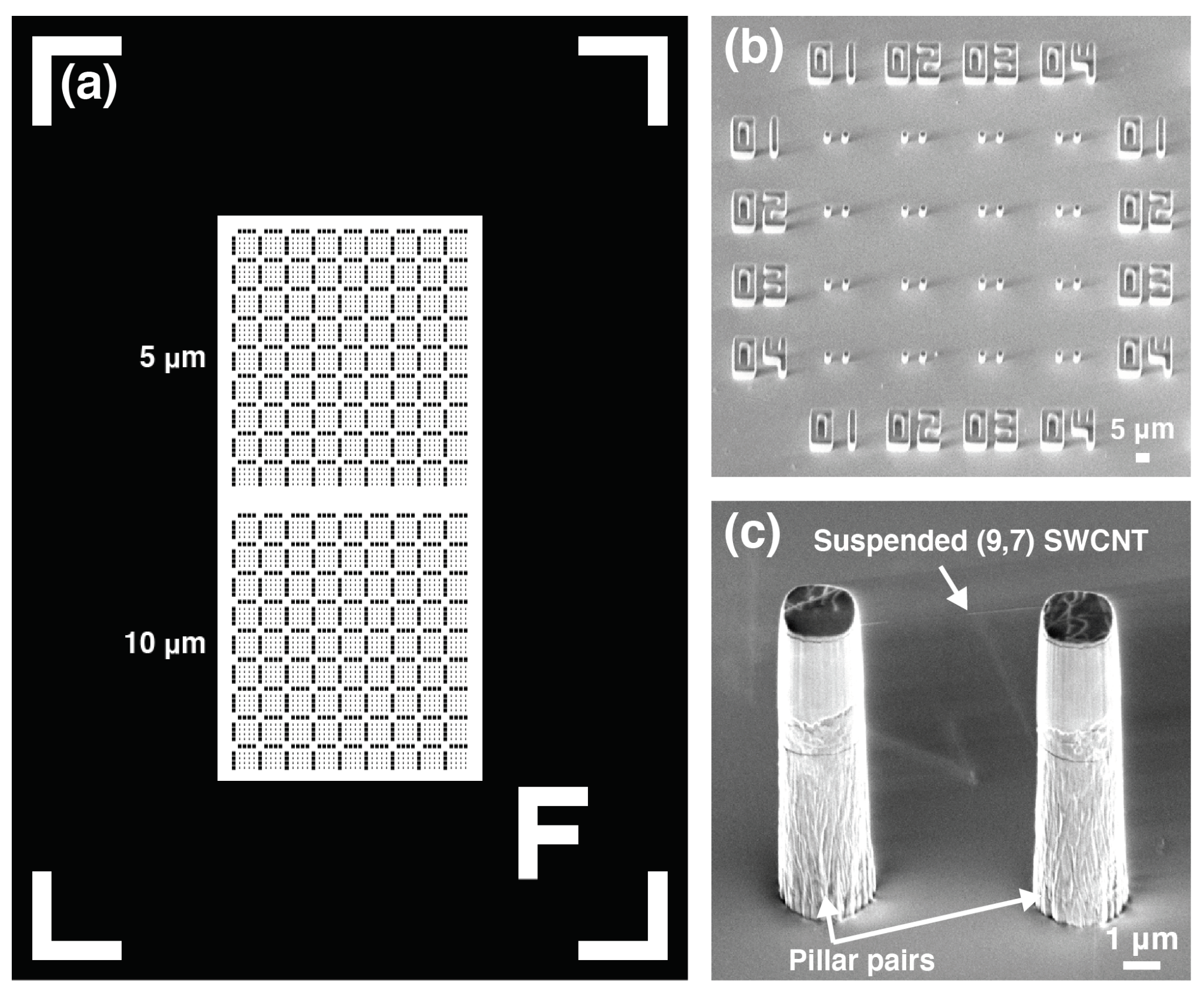
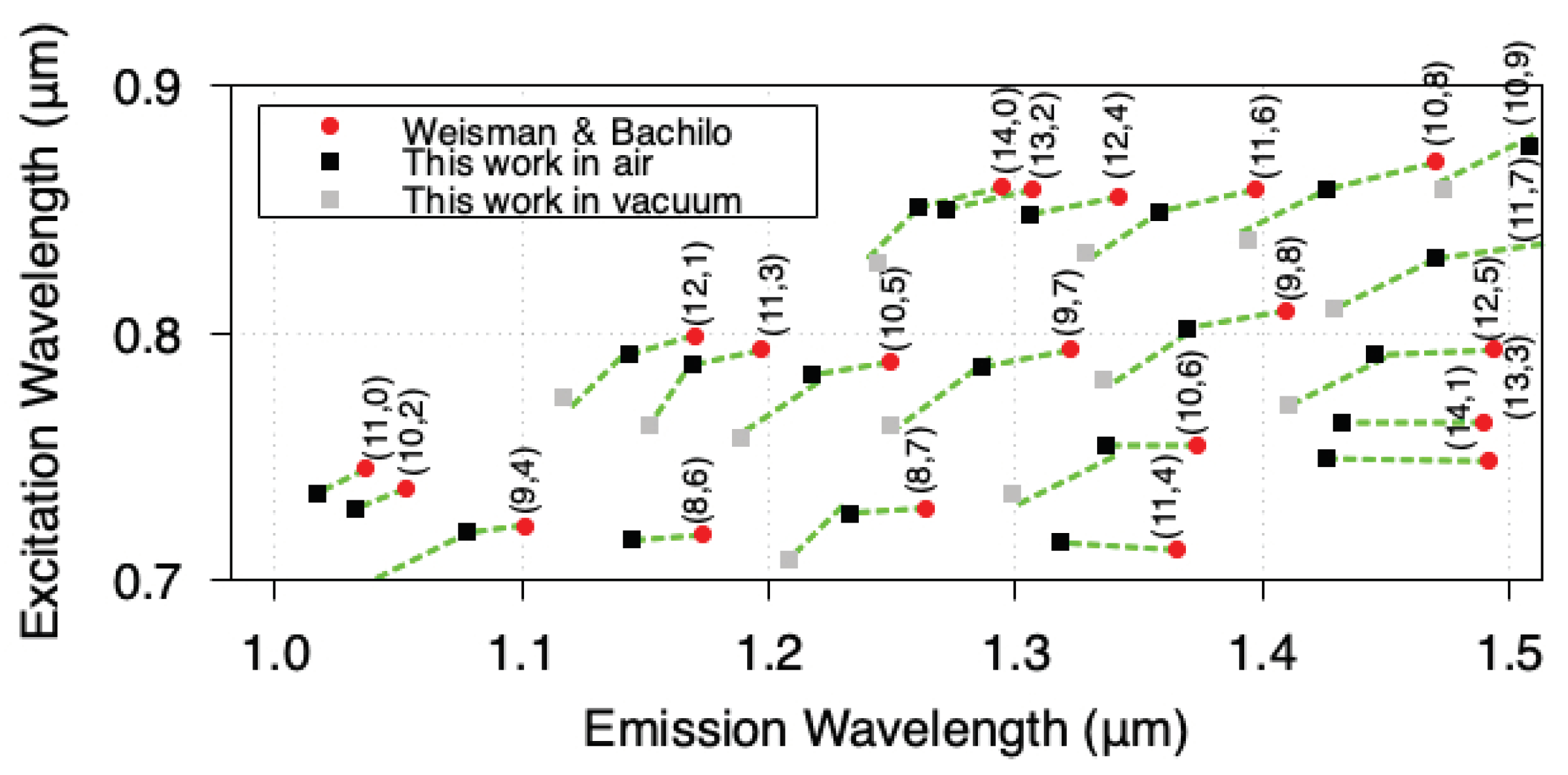
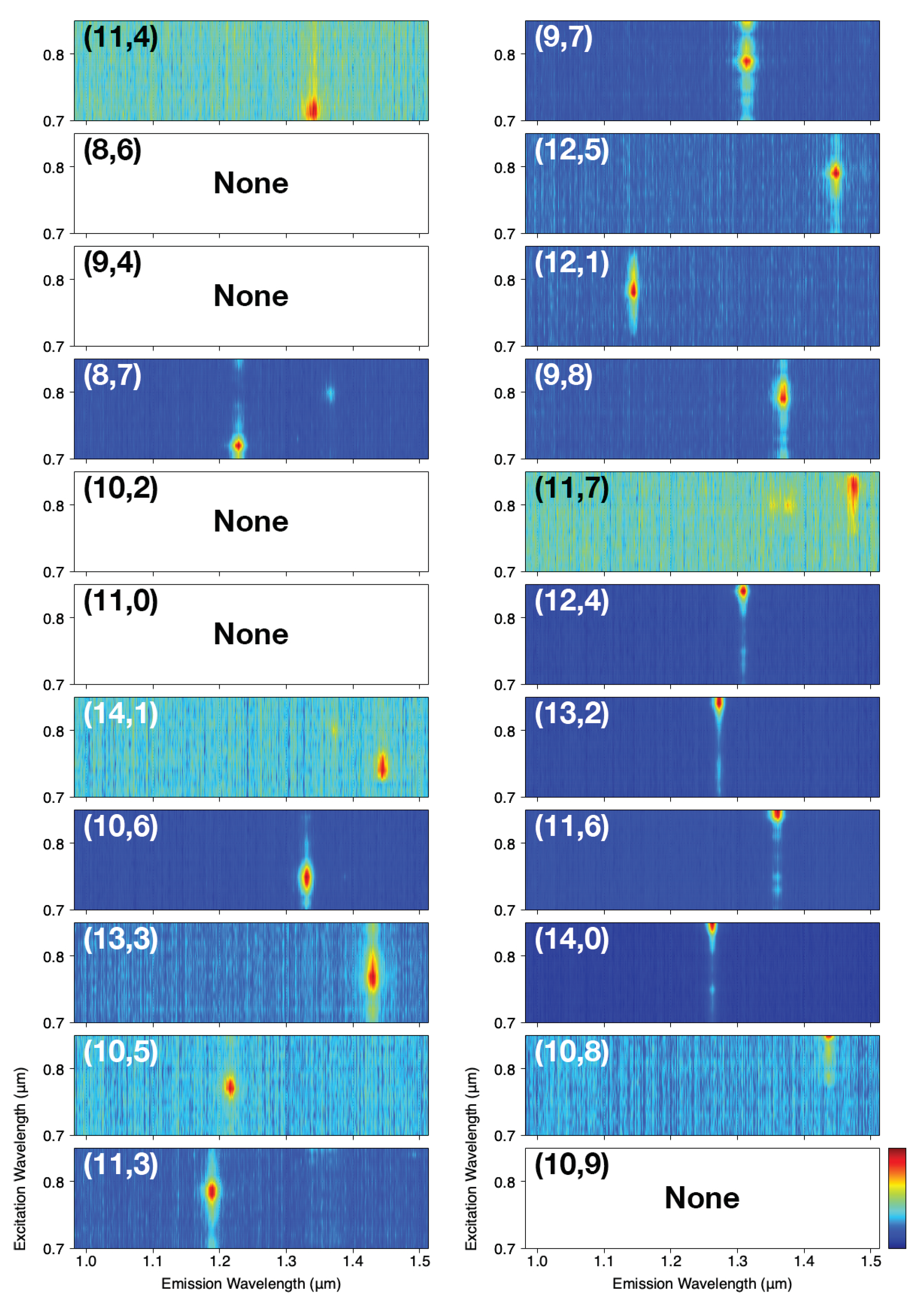
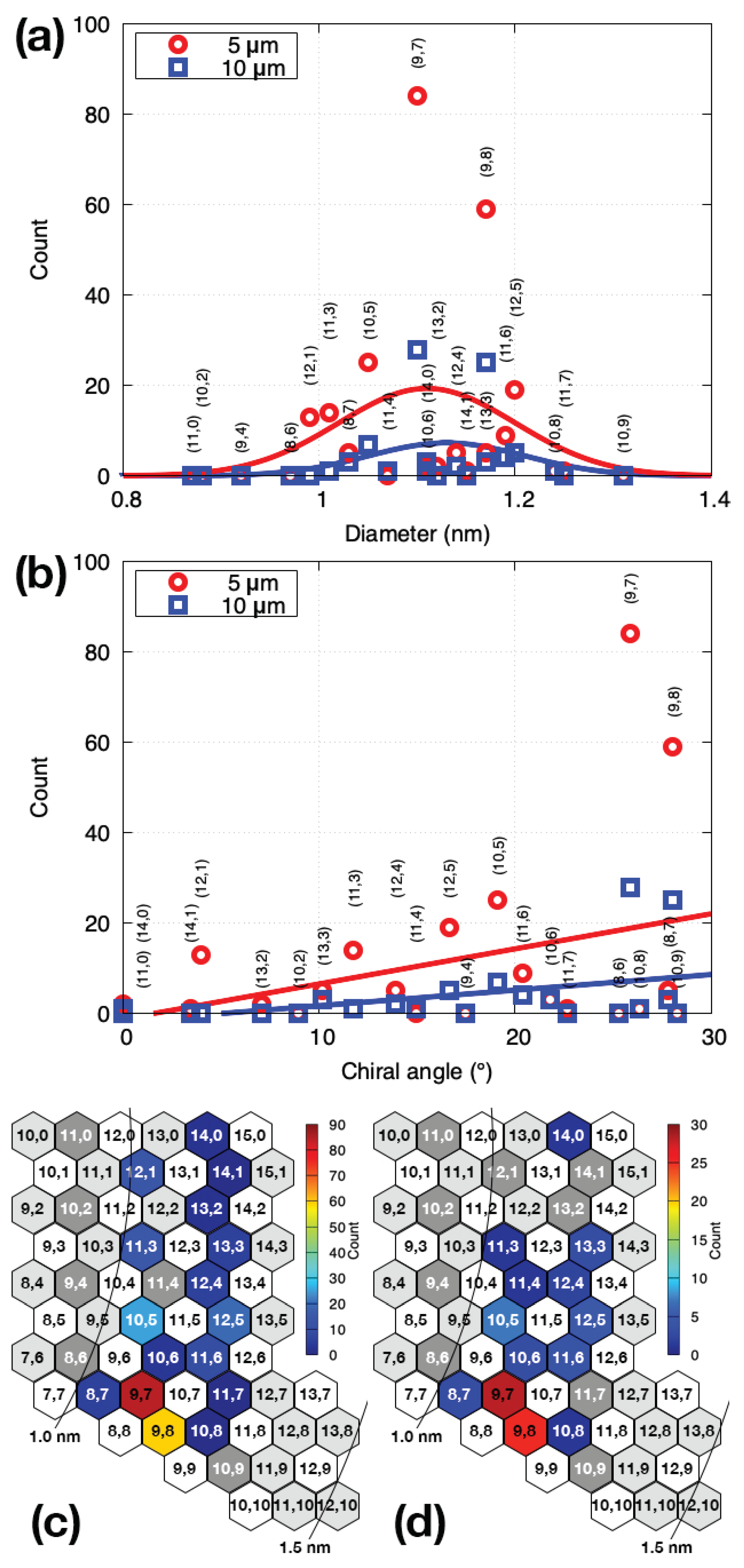
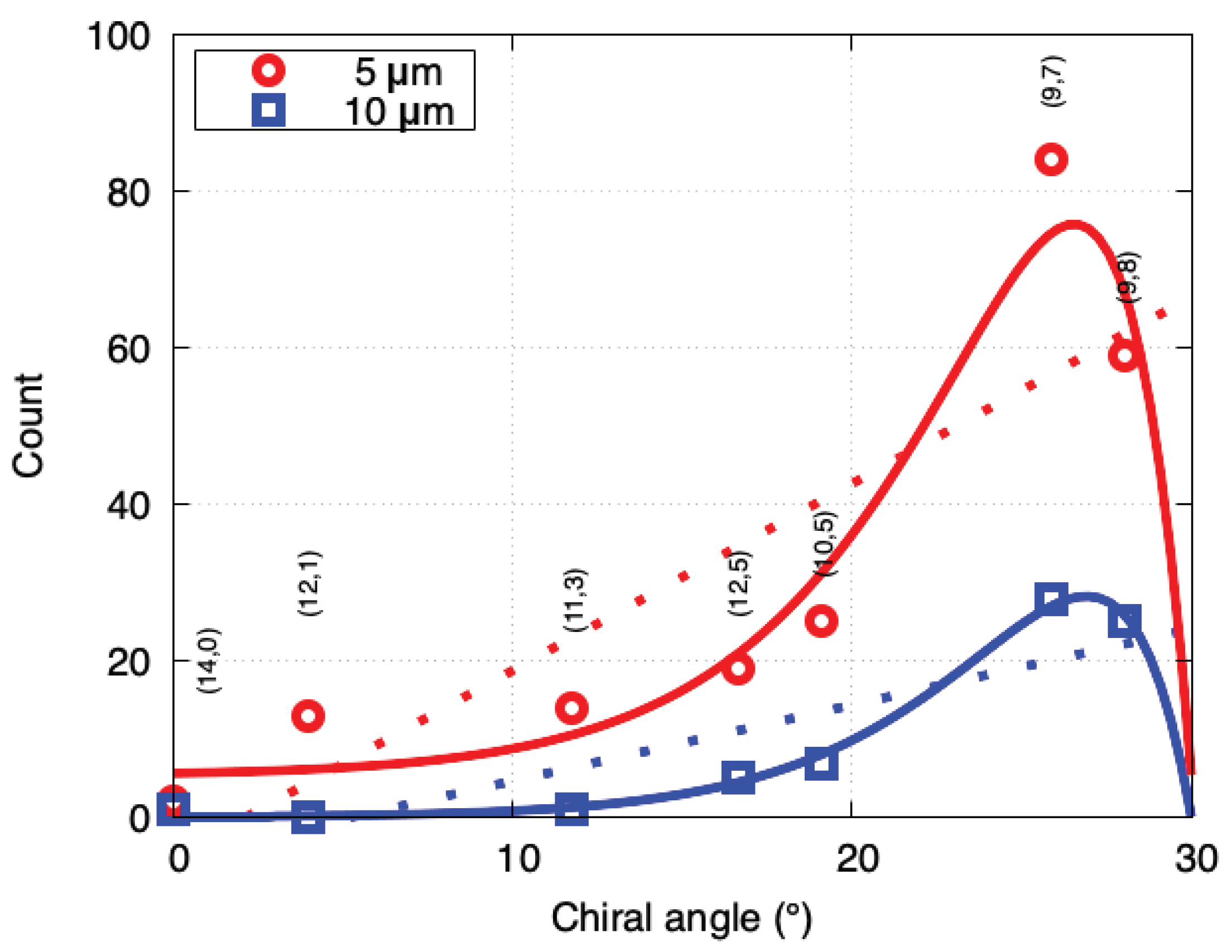
| # | |||||||||
|---|---|---|---|---|---|---|---|---|---|
| 1 | (11,4) | 1.07 | 14.92 | 1365 | 712 | 1318 | 715 | ||
| 2 | (8,6) | 0.97 | 25.28 | 1173 | 718 | 1145 | 716 | 1108 | 694 |
| 3 | (9,4) | 0.92 | 17.48 | 1101 | 722 | 1078 | 719 | 1043 | 697 |
| 4 | (8,7) | 1.03 | 27.80 | 1264 | 729 | 1233 | 727 | 1208 | 708 |
| 5 | (10,2) | 0.88 | 8.95 | 1053 | 737 | 1033 | 729 | ||
| 6 | (11,0) | 0.87 | 0.00 | 1037 | 745 | 1017 | 735 | ||
| 7 | (14,1) | 1.15 | 3.42 | 1492 | 748 | 1426 | 749 | ||
| 8 | (10,6) | 1.11 | 21.79 | 1374 | 754 | 1337 | 754 | 1299 | 735 |
| 9 | (13,3) | 1.17 | 10.16 | 1490 | 764 | 1432 | 764 | ||
| 10 | (10,5) | 1.05 | 19.11 | 1249 | 788 | 1218 | 783 | 1189 | 757 |
| 11 | (11,3) | 1.01 | 11.74 | 1197 | 793 | 1169 | 787 | 1152 | 763 |
| 12 | (9,7) | 1.10 | 25.87 | 1322 | 793 | 1286 | 786 | 1249 | 763 |
| 13 | (12,5) | 1.20 | 16.63 | 1494 | 793 | 1446 | 791 | 1411 | 771 |
| 14 | (12,1) | 0.99 | 3.96 | 1170 | 799 | 1143 | 791 | 1117 | 774 |
| 15 | (9,8) | 1.17 | 28.05 | 1410 | 809 | 1370 | 802 | 1336 | 781 |
| 16 | (11,7) | 1.25 | 22.69 | 1514 | 836 | 1470 | 830 | 1429 | 810 |
| 17 | (12,4) | 1.14 | 13.90 | 1342 | 855 | 1306 | 848 | ||
| 18 | (13,2) | 1.12 | 7.05 | 1307 | 858 | 1272 | 850 | ||
| 19 | (11,6) | 1.19 | 20.36 | 1397 | 858 | 1358 | 849 | 1328 | 832 |
| 20 | (14,0) | 1.11 | 0.00 | 1295 | 859 | 1261 | 851 | 1244 | 828 |
| 21 | (10,8) | 1.24 | 26.33 | 1470 | 869 | 1426 | 858 | 1394 | 838 |
| 22 | (10,9) | 1.31 | 28.26 | 1555 | 889 | 1508 | 876 | 1473 | 858 |
Publisher’s Note: MDPI stays neutral with regard to jurisdictional claims in published maps and institutional affiliations. |
© 2021 by the authors. Licensee MDPI, Basel, Switzerland. This article is an open access article distributed under the terms and conditions of the Creative Commons Attribution (CC BY) license (https://creativecommons.org/licenses/by/4.0/).
Share and Cite
Irita, M.; Yamamoto, T.; Homma, Y. Chirality Distributions for Semiconducting Single-Walled Carbon Nanotubes Determined by Photoluminescence Spectroscopy. Nanomaterials 2021, 11, 2309. https://doi.org/10.3390/nano11092309
Irita M, Yamamoto T, Homma Y. Chirality Distributions for Semiconducting Single-Walled Carbon Nanotubes Determined by Photoluminescence Spectroscopy. Nanomaterials. 2021; 11(9):2309. https://doi.org/10.3390/nano11092309
Chicago/Turabian StyleIrita, Masaru, Takahiro Yamamoto, and Yoshikazu Homma. 2021. "Chirality Distributions for Semiconducting Single-Walled Carbon Nanotubes Determined by Photoluminescence Spectroscopy" Nanomaterials 11, no. 9: 2309. https://doi.org/10.3390/nano11092309






